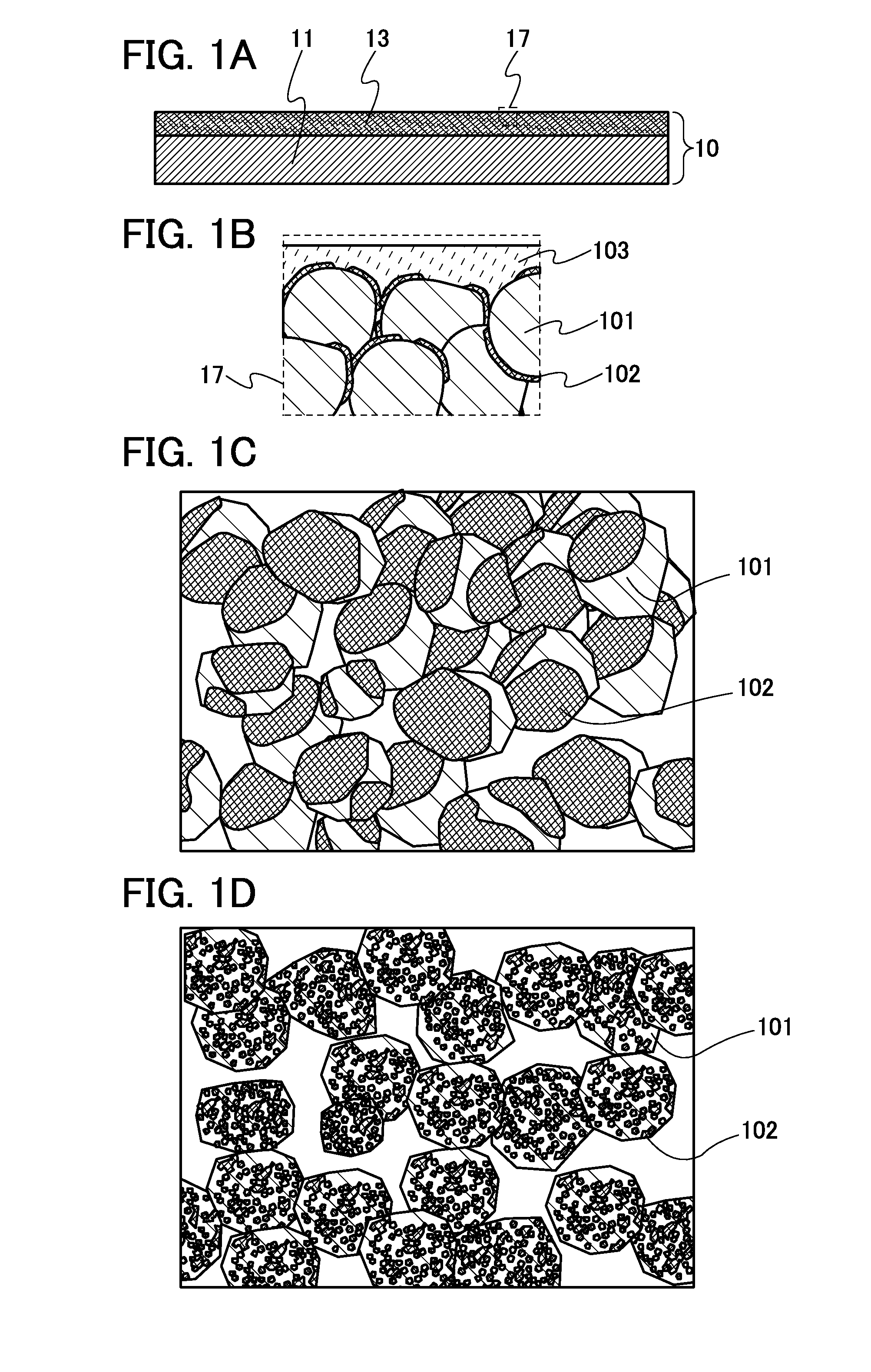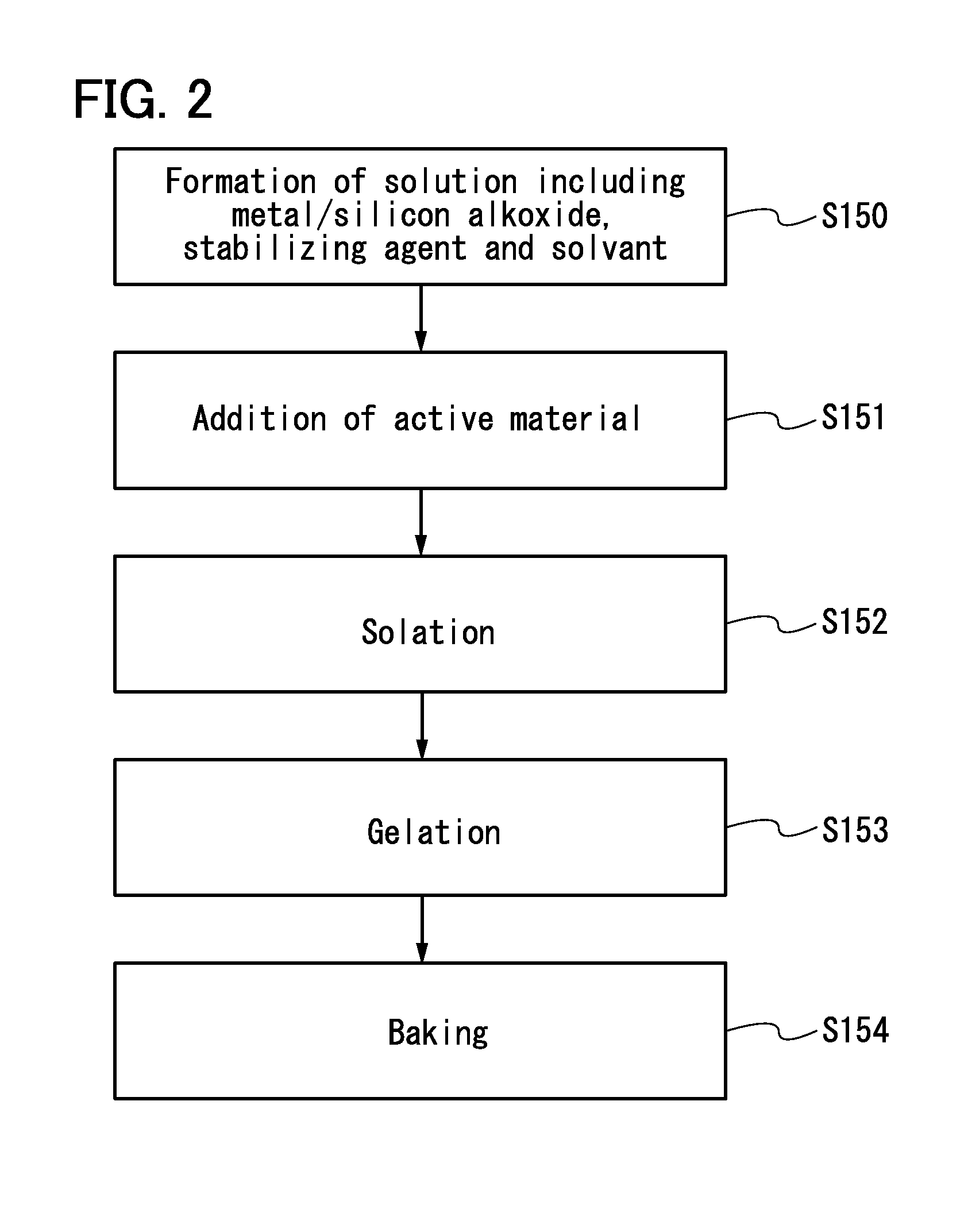Negative electrode for power storage device and power storage device
- Summary
- Abstract
- Description
- Claims
- Application Information
AI Technical Summary
Benefits of technology
Problems solved by technology
Method used
Image
Examples
embodiment 1
[0058]In this embodiment, a structure of a negative electrode active material having an inorganic compound film which can suppress a decomposition reaction of an electrolyte solution is described with reference to FIGS. 1A to 1D.
[0059]FIGS. 1A and 1B illustrate a negative electrode for a power storage device of the present invention. FIGS. 1C and 1D each illustrate a negative electrode active material used in the negative electrode for a power storage device.
[0060]FIG. 1A is a cross-sectional view of a negative electrode 10 including a negative electrode current collector 11 and a negative electrode active material layer 13 provided on one or both surfaces (on one surface in FIG. 1A) of the negative electrode current collector 11.
[0061]FIG. 1B is an enlarged cross-sectional view of part of the negative electrode active material layer 13 surrounded by the dashed line 17 in FIG. 1A. The negative electrode active material layer 13 includes a negative electrode active material 101 havin...
embodiment 2
[0084]In this embodiment, a method for forming a particulate negative electrode active material having an inorganic compound film on part of its surface is described with reference to FIG. 2.
[0085]First, as Step S150, a solvent to which metal alkoxide and a stabilizing agent are added is stirred to form a solution. Toluene can be used as the solvent, for example. Ethyl acetoacetate can be used as the stabilizing agent, for example. Alternatively, as Step S150, a solvent to which silicon alkoxide and a stabilizing agent are added is stirred to form a solution.
[0086]For the metal alkoxide, a desired metal used to form the inorganic compound film provided on part of the surface of the negative electrode active material is selected.
[0087]Next, as Step S151, the solution to which a particulate negative electrode active material such as graphite is added is stirred. The solution is made into thick paste by stirring the solution to which a solvent such as toluene is added, and the metal al...
embodiment 3
[0096]In this embodiment, a power storage device including the negative electrode described in Embodiment 1 and a method for forming the power storage device including the negative electrode are described with reference to FIGS. 3A to 3D, FIGS. 4A to 4C, FIG. 5A and 5B, FIG. 6, and FIGS. 7A and 7B.
[0097]First, a negative electrode for a power storage device using a particulate negative electrode active material having an inorganic compound film on part of its surface and a method for forming the negative electrode are described with reference to FIGS. 3A to 3D.
[0098]As illustrated in FIG. 3A, a negative electrode 200 includes a negative electrode current collector 201 and a negative electrode active material layer 202 provided on one or both surfaces (on the both surfaces in the drawing) of the negative electrode current collector 201.
[0099]The negative electrode current collector 201 is formed using a highly conductive material which is not alloyed with a carrier ion such as lithiu...
PUM
| Property | Measurement | Unit |
|---|---|---|
| Thickness | aaaaa | aaaaa |
| Thickness | aaaaa | aaaaa |
Abstract
Description
Claims
Application Information
 Login to View More
Login to View More - R&D
- Intellectual Property
- Life Sciences
- Materials
- Tech Scout
- Unparalleled Data Quality
- Higher Quality Content
- 60% Fewer Hallucinations
Browse by: Latest US Patents, China's latest patents, Technical Efficacy Thesaurus, Application Domain, Technology Topic, Popular Technical Reports.
© 2025 PatSnap. All rights reserved.Legal|Privacy policy|Modern Slavery Act Transparency Statement|Sitemap|About US| Contact US: help@patsnap.com



